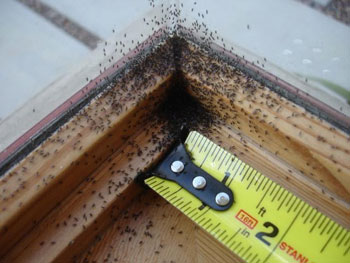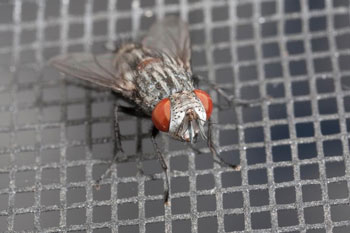

Flies of many kinds have affected humans and human welfare for thousands of years. Some flies suck blood; others are scavengers. Many transmit disease organisms, some are pests of cultivated plants, some live at the expense of other insects and others aid in the pollination of plants.
Flies of importance to urban pest managers fall into several groups. The family Muscidae includes the house fly and its relatives; the members of the family Sarcophagidae are flesh flies; the family Calliphoridae is made up of the bottle flies and the blow flies. Other families of importance are Simuliidae, black flies; Suchodidae, filter flies, or moth flies; Tabanidae, horse flies or deer flies; and Drosophilidae, vinegar flies.


All flies have completed metamorphosis, with egg, larval, pupil, and adult stages. Larvae feed differently and occupy different habitats than adults. The pupae are usually quiescent and often enclosed in a heavy pupal skin or puparium. Once the adult female has emerged and mated, she selects the larval habitat and deposits her eggs. The habitat selected is species dependent and may also differ seasonally, demographically, and with regards to types of habitats available. The length of the life cycle is both species and environmentally dependent.
Fly Management
Good sanitation is the basic step in all fly management. Whenever possible, food and materials on which the flies can lay their eggs must be removed, destroyed as a breeding medium, or isolated from the egg-laying adult. Killing adult flies will reduce any infestation, but elimination of breeding areas is necessary for good management. Where flies are a problem in buildings, the owner or occupants may be able to do this work; the pest management professional’s job is to seek out the breeding places and communicate how the work should be done.House flies and many flesh flies, bottle flies and blow flies breed in similar substances, such as decaying organic materials, garbage, animal excrement, or polluted ground. Removal of these from the vicinity of the infested premises will frequently make other measures unnecessary.
The importance of twice-weekly garbage removal doesn’t seem to be a necessity for fly control when the length of the life cycle required by the immature stage is noted in a cursory manner. The important thing to remember here is that the final larval instar leaves the larval food medium and wanders for considerable distances prior to pupation; so, it is the last larval instar that is important that necessitates twice weekly pickups.


Other considerations in sanitation include regular removal of livestock or pet manures, soiled bedding, straw, and all other decaying plant and animal matter. Garbage cans and dumpsters should have tight-fitting lids and be cleaned regularly. Dry garbage and trash should be placed in plastic garbage bags. Wet garbage should first be wrapped in old newspaper and then put in plastic garbage bags. All garbage receptacles should be located as far from the doors as possible.
Openings to buildings should be tightly screened with screen having a mesh no larger than 12 to the inch for the larger flies and 18 to the inch for the smaller insects. Eighteen-mesh screening is required to exclude mosquitoes but this reduces the amount of light and air that can pass through. Screen doors should open outward. For extreme infestations, adding a double set of doors may be of value. It is usually unnecessary to screen above the third story of a building.
Fly traps or flypaper may also be useful in some management situations. They require a sticky surface and contain a material attractive to flies. They may trap large numbers of flies but are most effective when used to supplement other management techniques. They are used in spots outside the limits of an area to be protected, however, may be of some value, as they undoubtedly reduce fly populations. Their use is usually limited to areas where aesthetics are not a primary importance.
Electrically charged screens and light traps are also available but can be used effectively only in certain areas. They should be used to supplement other management techniques. The number of light traps used in buildings (such as food-handling establishments) and their placement are critical factors in successfully using them in fly management. Thus, direction for installation, placement and maintenance should be obtained from Anteater Exterminating, Inc.
Indoor small light traps have become available recently. They provide a quick relief and can be very effective. Depending on the size of your structure and the extent of the problem, you may need to have more than one installed. For larger areas, commercial grade light traps can be utilized. Placement and ongoing maintenance are needed to ensure long term success. If the light traps are strategically deployed they can be high effective. Fly control is achieved in a percentage directly related to the number of the control options being deployed.
- Sanitation and harborage elimination will get 50-60% control.
- The use of fly baits outside around dumpsters and on wall services will achieve another 10-20% control.
- Putting light traps up inside will get you an additional 15-25% control. At best you might achieve 70-90% control over all.
- Inside you can achieve 95-100% control if you keep doors and windows shut, seal any openings where day light passes through and deploy light traps in sufficient numbers.
Anteater Exterminating, Inc. can analyze your particular situation and give you the most effective integrated fly control program available.
